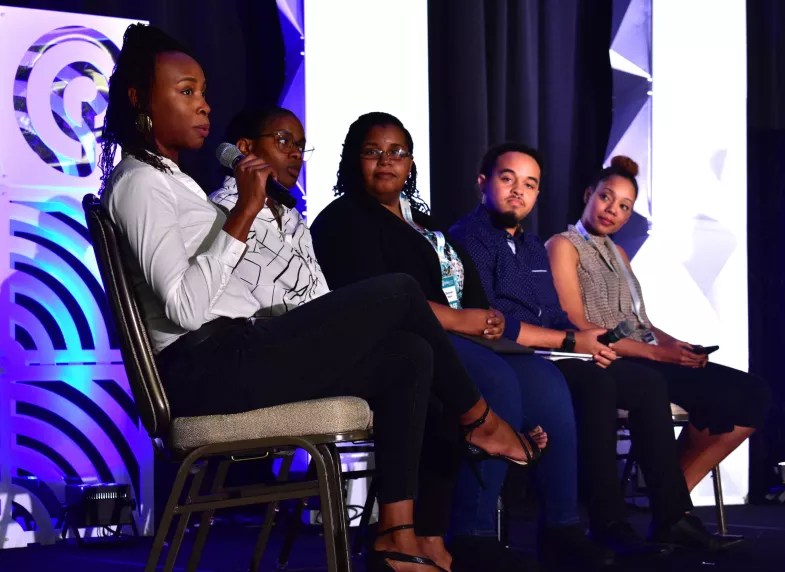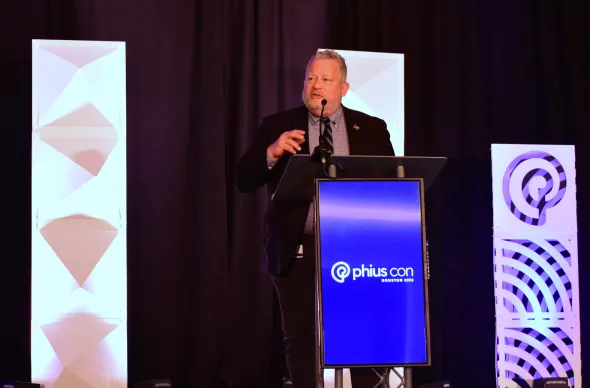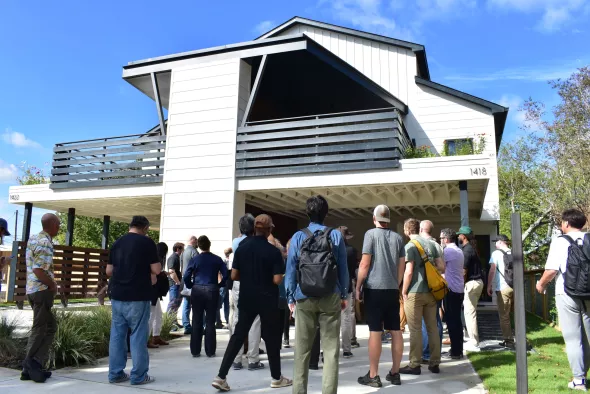PhiusCon 2023 in Texas – Mission Accomplished!
Phius Co-Founder & Executive Director Katrin Klingenberg reflects on PhiusCon 2023, which took place Nov. 7-10 in Houston, Texas.
Phius Co-Founder & Executive Director Katrin Klingenberg reflects on PhiusCon 2023, which took place Nov. 7-10 in Houston, Texas.

What a conference! We did it again! We always say “this was the best one, it can’t get better than this.” And then it does! Thank you all for attending and for making this event even more spectacular than last year. As always, the camaraderie, community and mutual support within our professional community is truly special.
In addition to that, we had a hunch: that the time is right for Texans to join us in our efforts of making passive and zero energy projects mainstream and the core of the new emerging renewable grid – and we were right on. An increased presence from participants globally, especially from hot and humid regions, showed the increasing global interest in what we have accomplished in creating climate-specific passive building standards. We had attendance and presentations from hot and humid climates as far away as Down Under, Japan, China, Nigeria, Ghana and Colombia.
The longstanding Phius Alliance Chapter in Austin, and the more recently activated one in Houston, primed the pump for years and were ready for us. The Texan showing, which included very large, well-known production builders, was impressive. Thank you for your trust and interest in Phius’ standards as the basis for zero energy construction in your hot and humid climate.

The welcome by Houston Council Member David Robinson showed the resolve and excitement demonstrated by the City’s commitment to make the Phius Certified, 4-unit Fly Flat microgrid project a reality within Houston’s city borders. And as before, the young team of former students who won the Grand Prize in 2018 at that year’s Race to Zero demonstrated again during their riveting keynote why we do what we do – why this type of housing is so key and was such a strong motivator for all of them in an attempt to solve the many challenges our communities face: those of resilience, independence, equity, social justice and climate.
As always, PhiusCon is a national conference and plenty of content was delivered representing all climates, from extremely cold to mixed humid and moderate.
The design competition winners are more and more impressive every year. Single-family projects from all over the country, including New Mexico and Arizona, were submitted, as well as Phius REVIVE retrofit projects envisioning our mutual future: the winners two gorgeous examples from Chicago. Beautiful large-scale affordable projects from New York City dominated the high-rise category. Low-rise and the new community design award featured beautiful large-scale for-profit developments from the West Coast and Kansas City, amazing achievements, really, demonstrating what is possible.
And the technical keynote on day two just blew us all away. A passive building standard written in code adoptable language, covering all building typologies sponsored by ASHRAE, is within reach, scheduled to be ready in 2025. A commercial, 12-story bank building, their new headquarters, case study located in San Antonio designed to follow the proposed standard, proving the point of the impact such a standard could have: fronting resilience and an EUI of about 13! I personally was blown away by that project the most. And Dr. Joe Lstiburek’s closing with the ominous title of “Wood is Good, it Grows on Trees” contained a gentle warning from a legendary building scientist on what to watch out for as we turn our attention to primarily renewable construction and insulation materials to reduce embodied carbon. So well done! All around.

It made me think “we got this.”
In closing, I was thrilled to announce that in 2024 we are going to do things a little differently with PhiusCon. In 2024, Phius will be appearing at the USGBC annual conference. We are delighted to have been asked to explore mutual synergies between the organizations in an effort to accelerate our growth and achieve our common mission: achieving sustainable zero energy construction in the built environment, so every building supports the health of people and planet.
In addition, we’ll also have a smaller dedicated event tailored to furthering best business practices of successfully delivering passive buildings on a mass scale in the Northeast.
I am over the moon with this decision for 2024 as I believe this two-prong approach represents the next step in going mainstream with what we do.
Before I go, a bit more on the fabulous sessions from this year’s PhiusCon. Since I could only be in one place at a time during the many outstanding sessions (5 parallel tracks), I asked the Phius Team and Board to send me their favorite sessions with a brief description of why. Enjoy!
Zoe Rader, Project Certifier and Policy Associate
“My favorite session was "Lessons Learned in Air Sealing" because multiple speakers were able to talk about their own experiences meeting our 0.06 cfm50/sf requirement and for different building types as well. It generated conversation with those attending, and I felt like it was very informative to all involved. On another note, it was nice seeing a few different sessions geared toward raters/verifiers.”
Max Lapthorne, Communications Manager
“My favorite session was The Fly Flat team presentation, because even though I've read plenty about the project, hearing the project team members explain why they are so passionate about it really showed the impact this project, and all passive building projects, can have.”
Terry Hill, Phius Board Member
“I liked all the sessions I went to including the one where the Australian paper was discussed. This paper, given my efforts to get passive house recognized in Oz, was particularly relevant for me as well as the problems my sister is still dealing with in London re: her house sealing problems. The other session was Joe’s on Wood. It seems to me that there is a great opportunity for a book that might come out of his effort, particularly where he mentions advances in wood usage. Seems an updated book that brings all these points together makes sense to me.”
Josh Ruedin, Professional Training and Education Programs Manager
“My favorite session was The Phuture. All three of the presentations challenged us to continue to strive to improve; from the training and preparation of young professionals to the changes coming to how transportation changes and technology will require us to reimagine our buildings/transportation and how they are used.”
Maren Longhurst, Phius Board Member
“Why can’t we all just get along, builder architect hootenanny. Great opportunity to have all those minds in the same room at the same time bouncing ideas off each other.”
Isaac Elnecave, Policy Specialist and Project Certifier
“My favorite presentation was by Ellen Franconi of PNNL on their resilience study which found a significant improvement in resiliency when building to Phius 2021 over either the existing building stock or IECC 2021. It brought home the importance and the need to communicate the non-energy benefits of building to Phius. “
Shannen Martin, Project Certifier
“My favorite was Solutions for Spicy Weather because the name was catchy. Kidding! The session introduced projects in climate zones 2A and 2B, stressed the importance of bringing all team members (including HVAC installers, etc.) together for pre construction meetings, and how they went about 'translating Phius language' for installers without prior Phius project experience to make sure they were all on the same page and the project was a success.”
Graham Wright, Senior Scientist
“Mine was the pre-conference workshop on Carbon Storing and Electrification. This made the most nuanced case I have seen for crediting some materials with negative emissions; though I still have reservations about this.”
Alan Gibson, Phius Board Member
“I will second Graham’s choice. It was a great workshop presenting some excellent tools. My second favorite was the Canadian presentation about developing a robust strategy for large-scale panelized retrofits.”
Walter Grondzik, Phius Board Member
“For presentations, the geek in me says the session on humidifiers >> who would have thought there were so many places you should not dump water vapor. Overall, the afternoon workshop on embodied carbon >> finally MEP systems get their carbon due, and it’s actually the refrigerants.”
Neil Rosen, Project Certifier
“I enjoyed the local Texas Case studies that showcased some of the project we saw during the building tour.”
Al Mitchell, Project Certifier
“I really enjoyed the modeling and tools session, PhiusCon is one of the few places where you can get down into the nitty gritty. Matthew Colturi from SGH gave a fascinating comparison of the different methods of calculating and provided advice on the scenarios in which each should be used. Valuable advice for the different phases of working on a passive project.”
Lisa White, Associate Director
“I enjoyed the "how NOT to do electrification" hootenanny. Not only did the presenters keep the room engaged (and throw around some great mechanical system puns), they also emphasized the importance of thoughtful electrification - not just electrification with whatever equipment is cheapest for the sake of getting off fossil fuels. They illustrated retrofit scenarios where both enclosure upgrades and high performance equipment choices made a significant impact on operational costs, and did some myth-busting on commonly misunderstood functionality of heat pumps and VRF systems.”
Steven Reid-Wynn, Office Administrator
“My favorite session was the Elevating Passive House Design Hootenanny. The group that gave the presentation was very engaging, encouraging, and provided some great insight into how they deal with clients and vendors.”
Michael Knezovich, Operations Director
“I moderated the carbon focused one that included David Salomon, Michael Hindle, Christina Assman and the Bill Shadid team. I liked it because it debunked a lot of stuff like if it's wood it must be good, and it focused on some non-building things like converting areas around buildings into native plant spaces--they sequester carbon and they don't take decades to mature.
Haley Kalvin-Gold, Project Certifier
“I really enjoyed the Architects & Builders hootenanny. It's clear that there is A LOT that needs to be talked about and kinks that need to be worked out, but the conversation has started. Synergy and effective communication between team members is the key to a successful project and I hope the attendees of this session continue to ask each other questions and have open discussions about their expectations, frustrations, and success stories.”